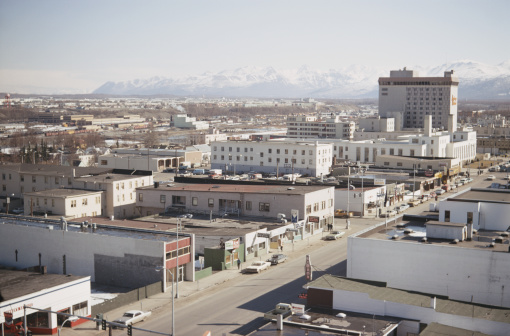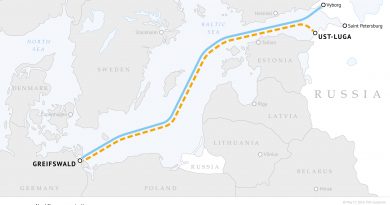Economist reflects on 100 years of shifting fortunes in Anchorage

In 2015, Anchorage will turn 100 years old. In the December issue of Alaska Economic Trends, local economist Neal Fried reflects on change in the city’s economy.
Fried notes that Anchorage is a relatively young city. “From its beginning, automobiles traveled its roads, electricity lighted its homes, and phones were commonplace.” Longtime residents, including Fried, have watched the economy grow and change.
Fried, 60, has been an economist in Anchorage since 1978 — more than a third of the city’s history. “I am sort of old,” Fried said with a laugh. “But I mean, I don’t think I am that old.”
Railroad plants seed for a city
Anchorage dates back to the establishment of a tent city in 1915, guided by President Woodrow Wilson’s April announcement that the site would be the Alaska Railroad headquarters.
The tent city eventually became home to 4,500 people, Fried wrote, although no U.S. Census data had been collected yet.
Fried said the decision to use Anchorage as the railroad hub was “sort of random.” According to Fried, Anchorage was chosen because of its central location between the Kenai Peninsula town of Seward and the Interior town of Fairbanks, as well as its proximity to Cook Inlet for shipping. Its “close proximity to the Matanuska coal fields” helped too.
But the tent city on the Ship Creek mud flats didn’t thrive for long. Sanitation concerns caused settlers to move to higher ground. And the start of World War I triggered a 50 percent population decline.
Wars hit the Anchorage economy
Anchorage wasn’t incorporated until 1920, more than two years after the United States entered World War I. “Building materials became scarce and many people were drafted, including a third of AEC (Alaska Engineering Commission) laborers,” Fried wrote.
The city’s first official census report that year claimed only 1,856 people resided in Anchorage. The economy of the territory buckled. Until the next world war, Anchorage “became a sleepy railroad town.” And like cities across the U.S., Anchorage felt the sting of the Great Depression with a sharp increase in unemployment, although Fried acknowledged data is hard to come by.
Then World War II did for Anchorage what it did for the rest of the nation — pulled it out of an economic hole.
Some 1,000 troops arrived in Anchorage in 1940. Three years later there were 152,000 — as Japanese and American troops battled in the Aleutian Islands. And in Anchorage, the Army’s Fort Richardson and Elmendorf Air Force Base — now combined and known as Joint Base Elmendorf-Richardson — were built.
By 1950, Anchorage accounted for 24.9 percent of the state’s population with 32,060 people, according to the U.S. Census Bureau.
“A lot of people weren’t too sure what would happen to Anchorage after the war. It was a military and government town; they had good reason to worry. But then the Cold War came along, (and) that no one could’ve predicted,” Fried said.
The military expanded once again in Alaska, Fried wrote. By 1952 about 25,000 troops were stationed in Anchorage. Seven years later, Alaska became the 49th U.S. state.
‘Giant paychecks’ and the oil boom
By the 1970s Alaska’s economy was driven by an entirely different industry — oil. Black gold didn’t affect just the Kenai Peninsula and Prudhoe Bay. It flowed into the Anchorage economy, which to this day remains the state’s oil headquarters.
Employment grew sixfold. “On an annual percent basis, employment in Anchorage grew faster during the first decade after statehood than it would in any future decade,” Fried wrote in the report.
Construction of the trans-Alaska pipeline employed 30,000 people at the peak. The report claims the average monthly paycheck in the construction industry was $4,041 in 1976, equivalent to about $14,000 today.
“The 1970s were the age of giant paychecks, fortunes earned and fortunes lost,” Fried wrote. “Not since then have so many people moved to the city, and never before had so many people left.”
By the 1980s, the oil industry had left Anchorage booming as the price of oil boomed. Fifty-seven thousand people arrived in Anchorage from 1980 to 1985, which meant more homes and infrastructure had to be built to support the population.
But eventually the economy turned. Oil prices collapsed, thousands of jobs were lost and the population dropped by about 10,000. Not until 1989, when Anchorage became a supply center for the Exxon Valdez oil spill cleanup effort, did the economy rebound.
New millennium
The millennium started strong, Fried wrote. Tourism flourished, oil activity was up, the price of minerals and seafood rose and health care expanded. Federal spending in Alaska nearly doubled from 2000 to 2009. And two wars meant a greater military presence once again.
Yet during the largest economic crisis the U.S. had seen since the Great Depression, “the national foreclosure nightmare wasn’t even a headline in Anchorage, and neither was unemployment.” Jobs fell by only 0.6 percent but bounced back and hit a record in 2011.
Fried said Anchorage’s economy is now more diverse than ever. He acknowledged there are “economic challenges to come,” though, as the future of oil is becoming murky, worrisome for lawmakers and big oil companies. But still, 100 years after tent city, he writes, we are still reaping the benefits of an expanding economy.
Related stories from around the North:
United States: Falling oil prices, revenue forecast, paint gloomy picture for Alaska, Alaska Dispatch



